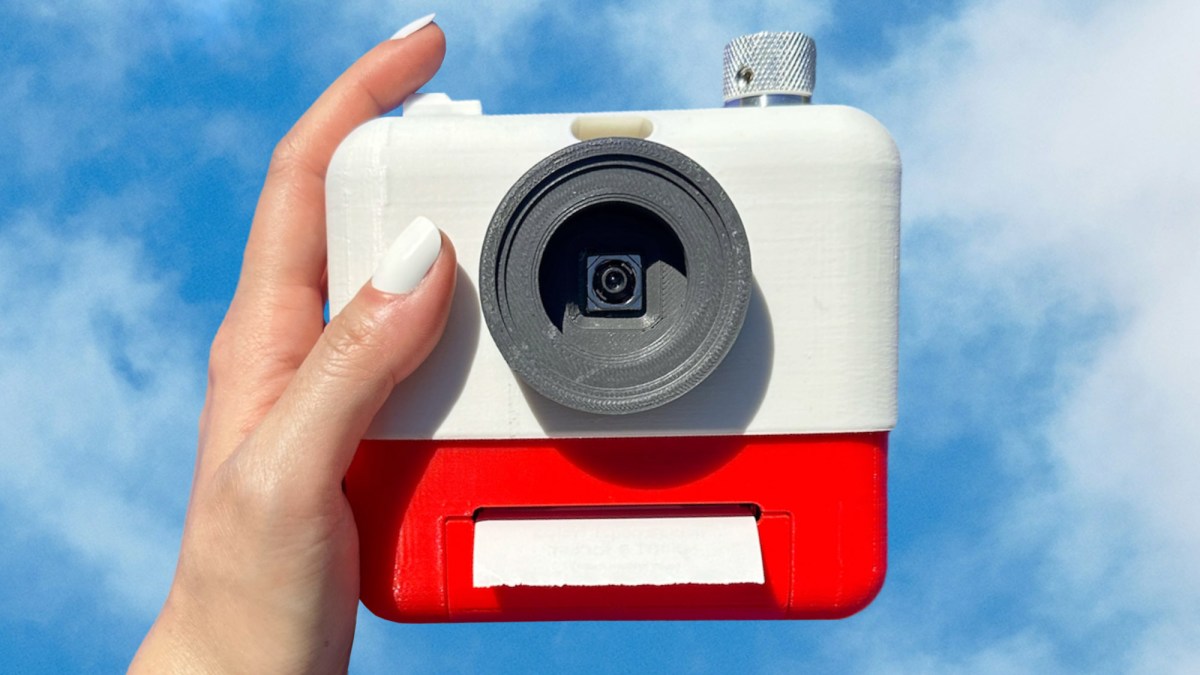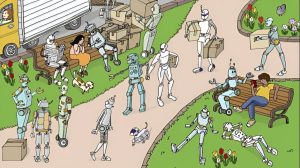Have you ever ever stand in entrance of a redwood and puzzled, “Wouldn’t it be great if this was poetry instead of a tree?” Neither did Joyce Kilmer. Kelin Carolyn Zhang and Ryan Mather, then again, have got down to bridge the distance between AI tech and poetry with their charming brainchild — the Poetry Camera. The visible supply tool combines state-of-the-art generation with creative eye, to effect a settingup that pushes the limits of each disciplines.
In the beginning look, the Poetry Digital camera turns out like every other machine within the ever-evolving soil of virtual units. Alternatively, upon nearer inspection, it turns into noticeable that that is refuse habitual digital camera. Rather of simply taking pictures photographs, the Poetry Digital camera takes the idea that of pictures to pristine heights by means of producing thought-provoking poetry (or, neatly, as thought-provoking as AI poetry can get) in accordance with the sights it encounters.
Zhang and Mather, the masterminds at the back of this challenge, have seamlessly combined their experience in generation and artwork to manufacture a technically important and aesthetically charming tool.
The tale of the Poetry Digital camera started as a private interest challenge for Zhang and Mather, who discovered themselves captivated by means of the theory of merging their love for generation with their hold in high esteem for the humanities. Within the early phases of construction, they spent numerous hours tinkering with diverse elements and experimenting with other AI fashions in order their eye to hour.
“The project’s origin is when I got access to GPT-3. My first instinct was to play Dungeons & Dragons with it because I’m a nerd. I figured ‘if this thing could play Dungeons & Dragons, that would be impressive.’ And yeah, it did work for that. This was back when you had to do prompt engineering. So it took some elbow grease to get it to work. But I also had this idea of maybe making some camera as a project,” says Mather. “What if you took a camera, but it was a reaction to Instagram culture? What if text comes out instead of a photo? … Everyone prefers the book version over the movie, so it’s like that for capturing moments.”
As they subtle their prototype, Zhang and Mather started to percentage their settingup with pals and community at social gatherings. The reactions they won have been not anything scale down of astonishing. Community have been fascinated about the idea that of a digital camera that might generate poetry in accordance with what it noticed. The tool briefly turned into the focus, sparking full of life discussions and igniting the creativeness of all who encountered it.
Those preliminary reactions have been an impressive motivator for Zhang and Mather to proceed refining their invention. They learned that the Poetry Digital camera had the prospective to bridge the distance between generation and artwork in some way that resonated with family. As promise of the Poetry Digital camera unfold, the duo have been inundated with inquiries from curious folks desperate to enjoy the tool for themselves. This hobby led them to imagine the opportunity of remodeling their challenge into a possible business product, making the necromancy of the Poetry Digital camera obtainable to a broader target audience.
The tech
On the middle of this cutting edge tool lies a Raspberry Pi, a credit score card-sized single-board laptop that packs an impressive punch. This negligible but mighty property serves because the mind of the Poetry Digital camera, enabling it to seize photographs and be in contact with OpenAI’s GPT-4 to generate poetry.
A Raspberry Pi captures the picture and next employs laptop eye algorithms to research the perceptible knowledge. The AI fashions next interpret the picture, figuring out key components, colours, patterns and feelings throughout the body. This knowledge serves because the bottom for the poetry-generation procedure.
Zhang pointed the digital camera at our Zoom interview:
Ryan Mather and Kelin Carolyn Zhang in an interview together with your correspondent. Symbol Credit: Screenshot from Zoom
And out got here a poem:
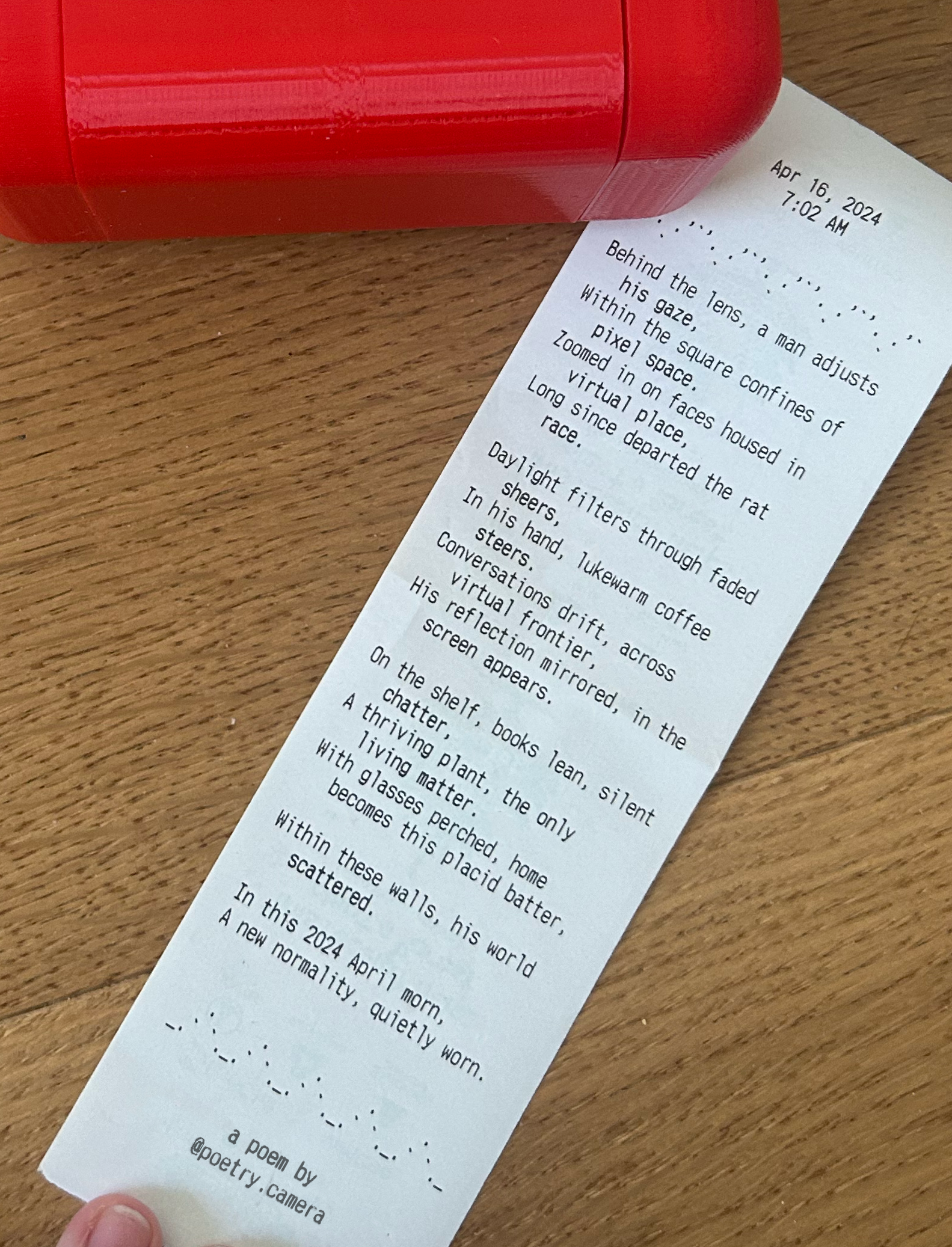
The poem generated and published by means of Poetry Digital camera (transcribed under). Symbol Credit: Poetry Digital camera
In the back of the lens, a person adjusts his gaze,
Inside the sq. confines of pixel dimension.
Zoomed in on faces housed in digital park,
Lengthy since departed the rat race.Sunlight filters via pale sheers,
In his hand, lukewarm espresso steers.
Conversations float, throughout digital frontier,
His mirrored image reflected, within the display seems.At the shelf, books incline, peaceful chatter,
A thriving plant, the one residing subject.
With glasses perched, house turns into his placid batter,
Inside this partitions, his international scattered.On this 2024 April morn,
A pristine normality, quietly impaired.A poem by means of @poetry.digital camera
Zhang theorizes that the connection with “departed from the rat race” is a connection with my Hawaiian blouse.
The inventors inform me that the Poetry Digital camera’s output isn’t restricted to a unmarried layout. Since the tool is visible supply, customers can make a choice from diverse poetic methods — reminiscent of haiku, sonnet or independent verse — relying on their personal tastes and skill and willingness to become involved with the supply code.
Because the Poetry Digital camera continues to adapt, Zhang and Mather are exploring pristine techniques to toughen its features. They repeatedly refine and choose the AI fashions, enlarge the tool’s activates and experiment with complex herbal language processing ways. The purpose is to manufacture a tool that generates poetry and engages in significant discussion with customers, fostering a deeper connection between generation and the humanities.
The intersection of artwork and generation
The Poetry Digital camera serves as a testomony to the unbelievable doable on the intersection of artwork and generation. By means of harnessing the facility of AI and device finding out, Zhang and Mather have created a tool that no longer handiest captures the wonderful thing about the sector round us but additionally translates it in some way that may be strangely touching. As generation, it’s easy, however I really like how obtainable Poetry Digital camera makes issues. It turns into really easy to dare to dream and push the limits of what generation can reach.
Monitors dominate our day-to-day lives; the Poetry Digital camera deals a refreshing depart from the norm. In lieu than depending on a virtual show to show off its poetic outputs, the tool employs a extra tactile and immersive form of interplay. The generated poems are published on paper, making a bodily embodiment of the creative enjoy. The transient nature of the artwork will get taken good-looking some distance with Poetry Digital camera.
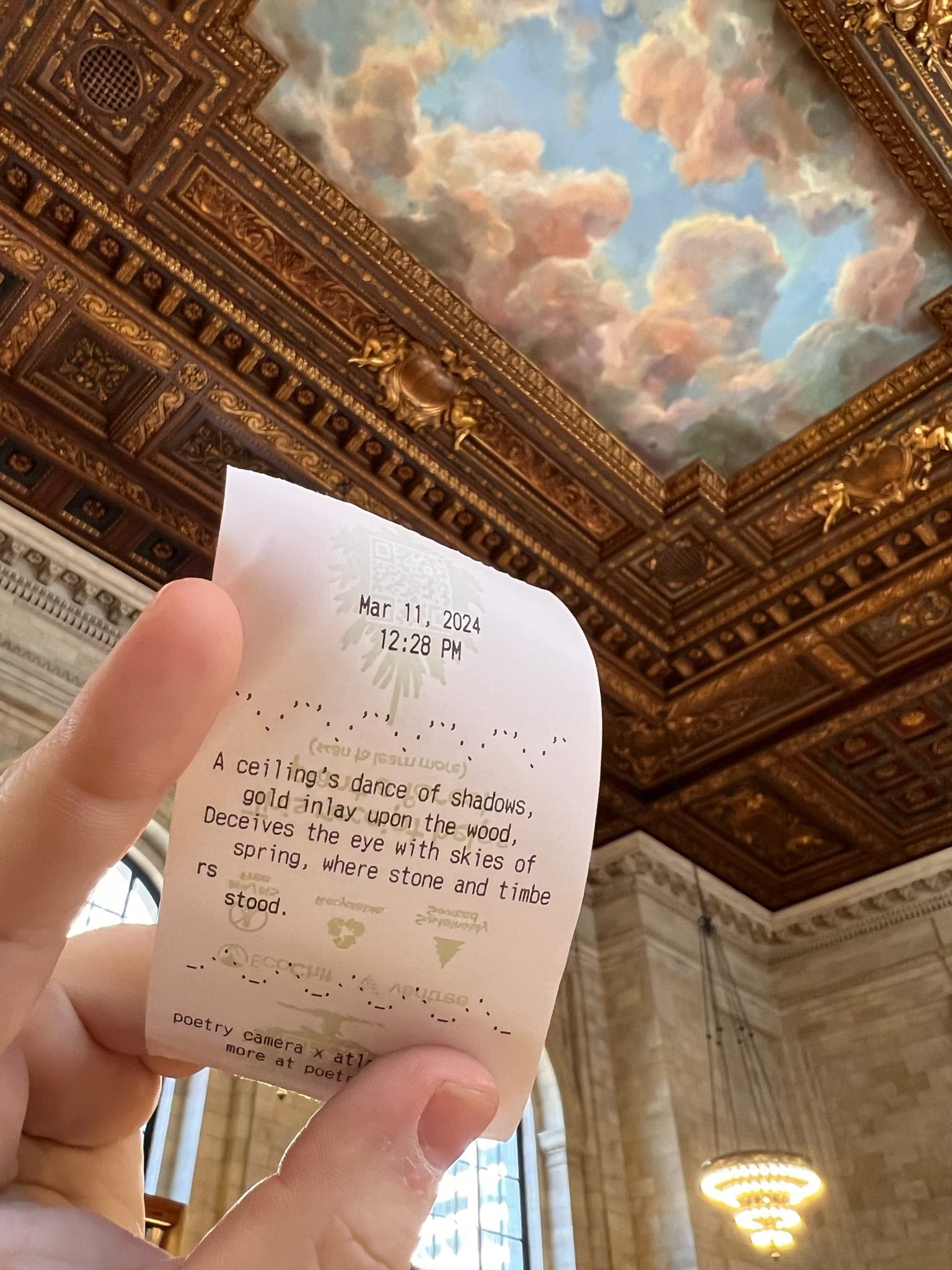
Every other pattern poem. Symbol Credit: Poetry Digital camera
“We don’t save any of the images or the poems digitally. There are a few reasons for that: One, it’s easier. Two: privacy. Three, it adds extra meaning to the poems if they’re like these ephemeral sorts of artifacts. If you lose it, it’s gone,” Mather explains. “Everyone has a camera in their pocket through their cell phone now — we wanted to do something very different.”
We’ve visible pristine UIs with merchandise like Plaud and the Humane Ai Pin — and this tool continues in the similar vein. It permits customers to disconnect from the consistent barrage of perceptible stimuli and interact with the Poetry Digital camera’s creations in a extra aware and contemplative means. To not get all artwork pupil, however the visceral enjoy of preserving a broadcast poem in my palms is a call for participation to mirror at the phrases, recognize the wonderful thing about the language and mode a deeper reference to the paintings.
The design philosophy extends past the tool, influencing all of the person enjoy. Zhang and Mather have in moderation crafted the Poetry Digital camera to foster a way of marvel and discovery. Shooting a picture, looking forward to the AI to generate a poem and next receiving the published output creates a way of chance and amaze, improving the full engagement with the tool.
A mirrored image of the life of AI and private computing
Zhang and Mather’s design philosophy for the Poetry Digital camera displays their broader eye for the life of private computing and AI. They imagine generation will have to be seamlessly built-in into our day-to-day lives, improving our stories with out overwhelming us with consistent stimuli. By means of developing a tool that prioritizes simplicity and inventive accentuation, they’re difficult the situation quo and paving the best way for a pristine day of generation.
“I think poetry cameras are a microcosm of what will happen to many industries with AI. Poetry cameras are unlike a traditional discipline: You never met someone who says, ‘Oh, I’m a poetry photographer for corporate events,’ laughs Zhang. Poetry Cameras are in between this established field of photography and poetry. It is this new, weird thing. Most importantly, watching people interact with them is enjoyable: People find childlike joy in their playful persona.”
What’s upcoming?
Because the Poetry Digital camera continues to captivate audiences and generate buzz, Zhang and Mather are in moderation making an allowance for the life in their cutting edge settingup. Pace the tool started as a private interest challenge, the overwhelmingly sure reaction has led them to discover the opportunity of making it commercially to be had to a broader target audience.
“After the first 100 times people asked, we said, ‘We’re not selling it,’ but after 101 questions, we started thinking about it in more detail, wondering if we should be making it available to people,” Zhang contemplates. “But at the same time, it’s an art project, you know? Our initial response was to leave capitalism out of it.”
Alternatively, true to their loyalty to sustainability and aware intake, Zhang and Mather are taking age prior to speeding into collection manufacturing. Rather, they’re taking a extra steady way, with the opportunity of restricted product drops that prioritize attribute over accumulation. By means of in moderation controlling the manufacturing procedure, they try to assure that each and every Poetry Digital camera is crafted with the extreme consideration to component and meets their top requirements for efficiency and sturdiness.
I challenged the staff on having to shop for a {hardware} product: Telephones have cameras, web connections and monitors. Wouldn’t it’s extra sustainable to utility {hardware} that already exists?
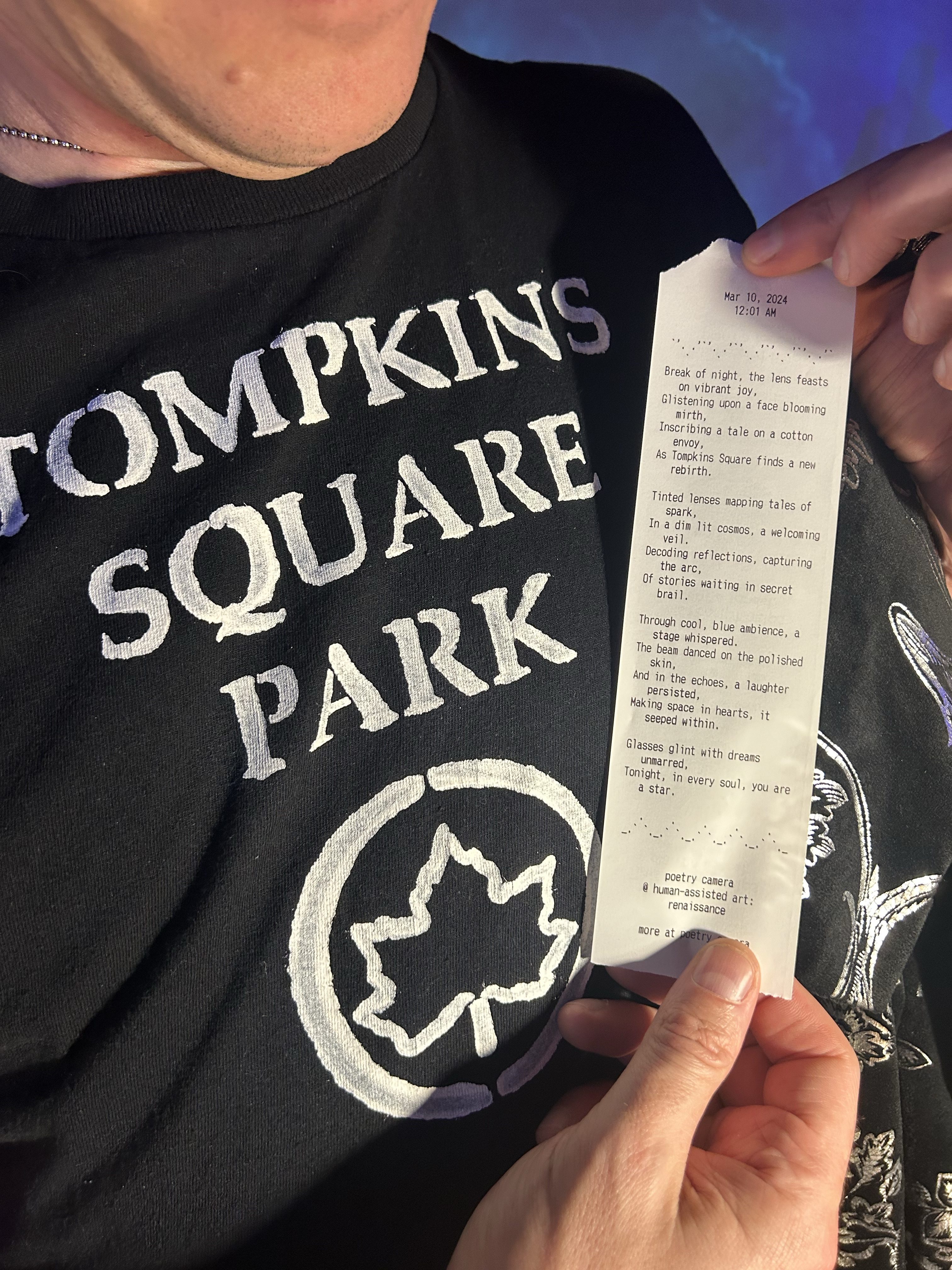
Every other pattern poem, with, within the background, the one that impressed it. Symbol Credit: Poetry Digital camera
“The most sustainable thing would be not to make anything at all,” Zhang consents. “But we initially started this as an open source DIY project, and we had all the instructions online; it was just that it’s hard for people to gather all the different parts needed. Initially, we played with the idea of creating a cardboard enclosure. But I’ve noticed that part of what makes people love and want to play with it is the sort of Poké Ball-polished product aesthetic. I think that for the Poetry Camera to come alive in its fullest form, it should be a polished-looking product. I don’t know how to approach it with sustainability in mind, but it’s important to us.”
Having a look forward, Zhang and Mather envision a life the place the Poetry Digital camera isn’t just a novelty tool however could also be a catalyst for exchange in how we have interaction with generation and artwork. They hope their settingup will encourage others to discover the intersection of those two disciplines, pushing the limits of what’s conceivable and developing pristine methods of accentuation.
I really like residing in an international the place determined leisure pursuits intersect with artwork and generation, and this challenge falls completely into that Venn diagram.
“For me, this continues to be art because it’s about expressing. It’s a vehicle for shaping a world that we want to see, which is a world where people can play with this new technology: AI is not all doom and gloom. And it’s not just about AI mimicking humans in a deeper, faster and worse way,” concludes Zhang. “It’s about making something entirely new with its new technology and bringing out that inner child again. For this project, it’s not about making money — it’s about making that childish wonder possible again.”
If you wish to have a better take a look at the digital camera in motion, TikTok seems to be the best resource.

